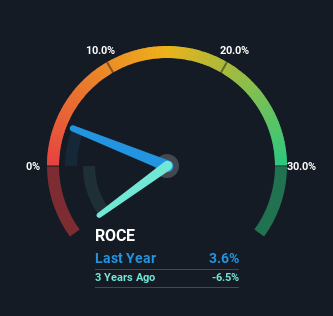- India
- /
- Energy Services
- /
- NSEI:DOLPHIN
Dolphin Offshore Enterprises (India)'s (NSE:DOLPHIN) Returns On Capital Are Heading Higher

Finding a business that has the potential to grow substantially is not easy, but it is possible if we look at a few key financial metrics. Ideally, a business will show two trends; firstly a growing return on capital employed (ROCE) and secondly, an increasing amount of capital employed. Put simply, these types of businesses are compounding machines, meaning they are continually reinvesting their earnings at ever-higher rates of return. With that in mind, we've noticed some promising trends at Dolphin Offshore Enterprises (India) (NSE:DOLPHIN) so let's look a bit deeper.
Return On Capital Employed (ROCE): What Is It?
For those that aren't sure what ROCE is, it measures the amount of pre-tax profits a company can generate from the capital employed in its business. Analysts use this formula to calculate it for Dolphin Offshore Enterprises (India):
Return on Capital Employed = Earnings Before Interest and Tax (EBIT) ÷ (Total Assets - Current Liabilities)
0.036 = ₹81m ÷ (₹2.3b - ₹50m) (Based on the trailing twelve months to June 2024).
Thus, Dolphin Offshore Enterprises (India) has an ROCE of 3.6%. Ultimately, that's a low return and it under-performs the Energy Services industry average of 8.0%.
View our latest analysis for Dolphin Offshore Enterprises (India)

While the past is not representative of the future, it can be helpful to know how a company has performed historically, which is why we have this chart above. If you'd like to look at how Dolphin Offshore Enterprises (India) has performed in the past in other metrics, you can view this free graph of Dolphin Offshore Enterprises (India)'s past earnings, revenue and cash flow.
What Can We Tell From Dolphin Offshore Enterprises (India)'s ROCE Trend?
We're delighted to see that Dolphin Offshore Enterprises (India) is reaping rewards from its investments and has now broken into profitability. Historically the company was generating losses but as we can see from the latest figures referenced above, they're now earning 3.6% on their capital employed. At first glance, it seems the business is getting more proficient at generating returns, because over the same period, the amount of capital employed has reduced by 51%. Dolphin Offshore Enterprises (India) could be selling under-performing assets since the ROCE is improving.
On a related note, the company's ratio of current liabilities to total assets has decreased to 2.2%, which basically reduces it's funding from the likes of short-term creditors or suppliers. Therefore we can rest assured that the growth in ROCE is a result of the business' fundamental improvements, rather than a cooking class featuring this company's books.
The Key Takeaway
In a nutshell, we're pleased to see that Dolphin Offshore Enterprises (India) has been able to generate higher returns from less capital. And with the stock having performed exceptionally well over the last five years, these patterns are being accounted for by investors. So given the stock has proven it has promising trends, it's worth researching the company further to see if these trends are likely to persist.
If you want to continue researching Dolphin Offshore Enterprises (India), you might be interested to know about the 3 warning signs that our analysis has discovered.
While Dolphin Offshore Enterprises (India) isn't earning the highest return, check out this free list of companies that are earning high returns on equity with solid balance sheets.
If you're looking to trade Dolphin Offshore Enterprises (India), open an account with the lowest-cost platform trusted by professionals, Interactive Brokers.
With clients in over 200 countries and territories, and access to 160 markets, IBKR lets you trade stocks, options, futures, forex, bonds and funds from a single integrated account.
Enjoy no hidden fees, no account minimums, and FX conversion rates as low as 0.03%, far better than what most brokers offer.
Sponsored ContentNew: Manage All Your Stock Portfolios in One Place
We've created the ultimate portfolio companion for stock investors, and it's free.
• Connect an unlimited number of Portfolios and see your total in one currency
• Be alerted to new Warning Signs or Risks via email or mobile
• Track the Fair Value of your stocks
Have feedback on this article? Concerned about the content? Get in touch with us directly. Alternatively, email editorial-team (at) simplywallst.com.
This article by Simply Wall St is general in nature. We provide commentary based on historical data and analyst forecasts only using an unbiased methodology and our articles are not intended to be financial advice. It does not constitute a recommendation to buy or sell any stock, and does not take account of your objectives, or your financial situation. We aim to bring you long-term focused analysis driven by fundamental data. Note that our analysis may not factor in the latest price-sensitive company announcements or qualitative material. Simply Wall St has no position in any stocks mentioned.
About NSEI:DOLPHIN
Dolphin Offshore Enterprises (India)
Provides offshore and marine services to the oil and gas industry in India.
Acceptable track record with mediocre balance sheet.
Market Insights
Community Narratives



